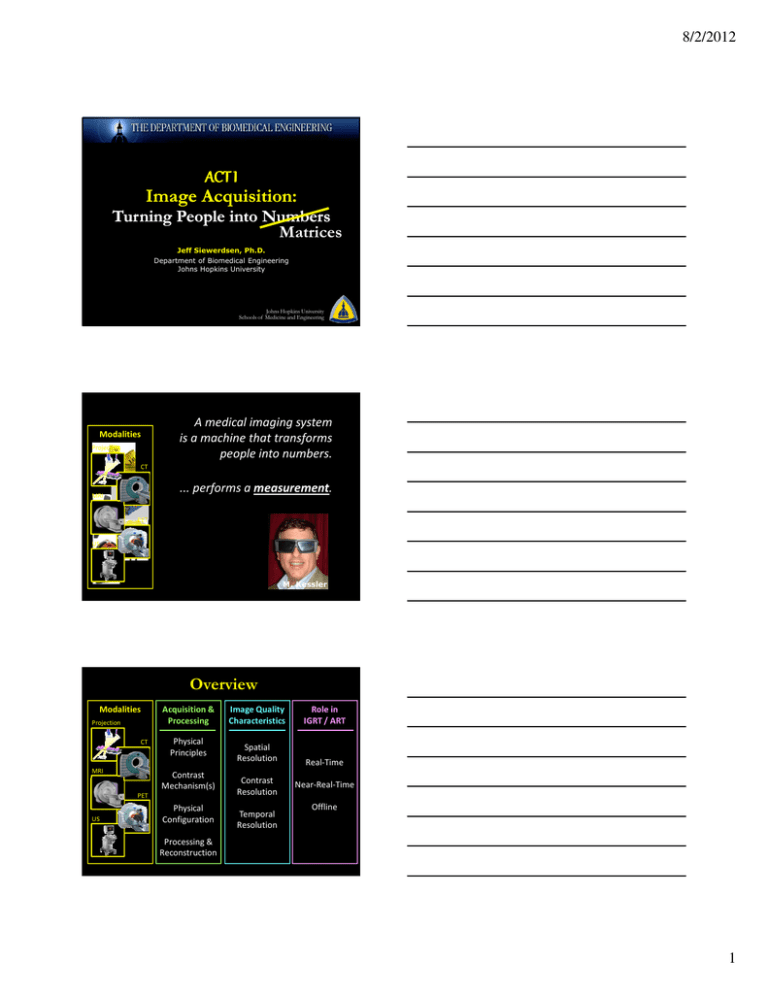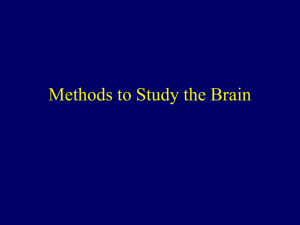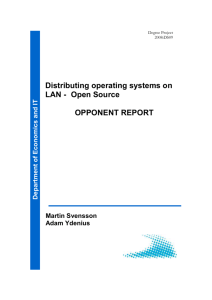ACT I Image Acquisition: Turning People into Numbers Matrices
advertisement

8/2/2012
ACT I
Image Acquisition:
Turning People into Numbers
Matrices
Jeff Siewerdsen, Ph.D.
Department of Biomedical Engineering
Johns Hopkins University
Johns Hopkins University
Schools of Medicine and Engineering
A medical imaging system
is a machine that transforms
people into numbers.
Modalities
Projection
CT
... performs a measurement.
MRI
PET
US
M. Kessler
Overview
Modalities
Acquisition &
Processing
Projection
CT
MRI
Physical
Principles
Contrast
Mechanism(s)
PET
US
Physical
Configuration
Image Quality
Characteristics
Role in
IGRT / ART
Spatial
Resolution
Real-Time
Contrast
Resolution
Temporal
Resolution
Near-Real-Time
Offline
Processing &
Reconstruction
1
8/2/2012
Object
Projection
Source
Detector
Acquisition
& Processing
CT
MRI
PET
US
Processor
Observer
Display
Acquisition & Processing
Source
Object
Detector
Projection
CT
MRI
µ(x,y,z;E)
PET
q(E)
US
Screen-Film (kV) or Cu+Film (MV)
Computed Radiography (CR)
XRII or Flat-Panel Detector
Boone & Seibert, Med. Phys. 24(11): 1661 (1997)
Acquisition & Processing
Contrast Mechanism: Attenuation
Projection
x
µ I
y
CT
I0
MRI
Kupelian et al.
PET
US
Beer’s Law
− µ ( x , y )dy
I = I 0e ∫ IJROBP 62(5) (2005)
Line Integral p ( x ) = ln I 0
Contrast
d
= µ ( x , y )dy
I ∫
0
d
d
∆p = ∫ µ ( x, y )dy − ∫ µ ( x, y )dy
x1
x2
0
0
2
8/2/2012
Acquisition & Processing
Projection
Detector
CT
Sinogram
p(ξ
ξ;θ
θ)
θ
RampKernel(ξ
ξ)
MRI
x
y
Object
µ(E)
PET
US
ξ
Source
q(E)
Acquisition & Processing
Backprojection
Projection
CT
Σ
Sinogram
θ
# of voxels
Repeat ×
# of proj
p(ξ
ξ;θ
θ)
RampKernel(ξ
ξ)
MRI
PET
US
ξ
Acquisition & Processing
CBCT
Projection
CT
MDCT ∆µ
Contrast Mechanism:
Hounsfield Units (HU)
µ - µwater
HU =1000 µwater
MRI
4D CBCT
Fat (-100)
PET
Liver (+85)
US
Polyeth (-60)
Water (0)
Breast (-50)
Brain (8)
3
8/2/2012
Acquisition & Processing
Projection
CT
Detector
MRI
Gz
Object
B0
PET
Gy
Gx
US
Source
Acquisition & Processing
Physical Principle: Spin-Lattice & Spin-Spin
Projection
CT
MRI
Note
PET
Magnetic dipoles
(ie, protons, H2O)
in random orientation
US
Dipoles align
with (or against)
direction of the B0 field.
Dipoles precess
about the B0 field
ω = γ B0
Larmor Frequency
Acquisition & Processing
Physical Principle: Spin-Lattice & Spin-Spin
Projection
Net Longitudinal
Magnetization
CT
Mo=M
z
Transverse
Magnetization
Spin Flip +
Phase Coherence
Mxy
Bo
MRI
Note
PET
US
RF pulse (B1 field)
at Larmor frequency
in transverse plane
Flip Angle
α = γB1τ
4
8/2/2012
Acquisition & Processing
Physical Principle: Spin-Lattice & Spin-Spin
Projection
CT
Longitudinal Relaxation
→ increase in
Longitudinal Magnetization (Mz)
MRI
Transverse Relaxation
→ decrease in
Transverse Magnetization (Mxy)
0.63
0.37
PET
US
1
Time
2
3
T1 Spin-Lattice
Relaxation Time
1
2
3
Time
T2 Spin-Spin
Relaxation Time
Acquisition & Processing
Contrast Mechanism(s): Relaxation Time
Projection
Spin-Lattice
T1 Contrast
MRI
PET
US
Longitudinal Magnetization
CT
Tissue T1 (ms)
Fat 260
Liver 500
White 780
Muscle 870
Gray 920
CSF 2400
∆ Mo
Time
Y Cao (U-Michigan)
Acquisition & Processing
Contrast Mechanism(s): Relaxation Time
Projection
Spin-Spin
T2 Contrast
Transverse Magnetization
CT
T1
T1 (SE)
MRI
PET
US
Tissue T2 (ms)
Fat 80
Liver 42
White 90
Muscle 45
Gray 100
CSF 160
DWI
∆Mxy
Gd
T2 (TSE)
Images from:
Time
Khoo et al. Br. J. Rad. (1999)
Dawson et al. (PMH)
Ghilezan et al. IJROPB (2001)
T2
Flair
Y Cao (U-Michigan)
5
8/2/2012
Acquisition & Processing
Basic Physical Principle
Projection
PMT
Detector
CT
MRI
18F→
→18O+e++ν
ν
Object
PET
Source
PMT
US
Source
Acquisition & Processing
Image Reconstruction
Sinogram p(ξ
ξ;θ
θ)
Projection
y
θ
Axial
CT
FBP
MRI
PET
x
ξ
PET-CT
PET
US
DW Townsend et al, Sem. Nuc. Med. (2003)
R. Jeraj (U-Wisconsin)
Acquisition & Processing
Basic Principles
Projection
Pulse-Echo Imaging
Source
Detector
Range
Equation:
CT
MRI
Object
US
Transducer Array
PET
Near
Source-Detector
Field
Transducer
Focal
Zone
Far
Field
6
8/2/2012
Acquisition & Processing
Basic Principles
Pulse-Echo Imaging
Projection
Velocity of sound
Reflection / Impedance
Bulk modulus (“stiffness”)
CT
θi θr
Z1
Density
Z2
θt
MRI
PET
US
Material: v (m/s): Z (Mrayls): R (soft tissue):
Air
330
0.0004
1.00
Reflectivity
Lung
600
0.18
0.79
Fat
1460
1.34
0.07
Water
1480
1.48
0.02
Soft tissue 1540
1.54
0
Acoustic
Liver
1555
1.65
0.03
Impedance
Blood
1560
1.65
0.03
Kidney
1565
1.63
0.03
Muscle
1600
1.71
0.05
Bone
4080
7.80
0.67
Acquisition & Processing
Basic Principles
Projection
Object
CT
Transducer
MRI
B-Mode 2D Sector Image
PET
Prostate
Cervix
US
W. Tome (U-Wisconsin)
Elekta (ClarityTM)
Contrast is higher in CT
than x-ray projections, because:
0%
0%
0%
0%
0%
1.
2.
3.
4.
5.
CT uses a higher dose.
CT uses contrast agents.
CT uses lower-energy x-rays.
CT has lower noise.
Because:
10
7
8/2/2012
Contrast is higher in CT
than x-ray projections, because:
1.
2.
3.
4.
5.
CT uses a higher dose.
CT uses contrast agents.
CT uses lower-energy x-rays.
CT has lower noise.
Because:
Imaging Performance
Accuracy
(Quantitation)
Acquisition
&
Image Quality
Role in
Extent to which the measured value equals the ‘true’ value
Processing
Characteristics
IGRT / ART
Vital to longitudinal imaging, QI:
Modalities
Projection
CT
MRI
PET
Monitoring ( SUV → remission)
(BMD →
osteoporosis)
Spatial
(µ → dose calculation)
Physical
Diagnosis
Principles
Tx planning
Resolution
Real-Time
Precision
(i.e., “Resolution”)
Contrast
Contrast
Min interval in {DIM} for which
two stimuli can be distinguished
Near-Real-Time
Mechanism(s)
Spatial Resolution
Resolution
x
Physical
the
Configuration
measured
US
property
→ lp/mm… PSF, LSF, ESF… MTF
Offline
(≠ pixel size!)
Temporal
Contrast Resolution
Resolution
→ contrast… noise… CNR (SDNR)
Processing &
t
Reconstruction
(≠ a display parameter)
Temporal Resolution
→ speed… temporal MTF (≠ fps)
cuiusmodi “Resolution”
Spatial Resolution
Modalities
12
Projection
11
10
13
14
15
CT
16
Contrast Resolution
MRI
PET
Temporal Resolution
US
Direct analogue to spatial resolution
(with 1-sided causal response)
8
8/2/2012
Imaging Performance
Quantitative Spatial
Contrast Temporal
Accuracy Resolution Resolution Resolution
Modalities
Projection
CT
+++
(but 2D)
---
++
+
+
+++
+
-
++
+
++
+
++
-
MDCT
MRI
CBCT
PET
US
--++
+
--+
+
+++
Rad
Fluor
3D
4D
3D
Cine
3D
4D
Role in IGRT / ART
Modalities
Acquisition &
Processing
Projection
CT
MRI
Image Quality
Characteristics
Physical
Principles
RealContrast
Time
Mechanism(s)
PET
Spatial
Resolution
Contrast
Resolution
Role in
IGRT / ART
Real-Time
OffLine
Near-Real-Time
Physical
On-Line
Temporal
Configuration
Resolution
US
Offline
Processing &
Reconstruction
Temporal Scales of Intervention
Role in IGRT / ART
Temporal Scales of Acquisition
Radiography
Projection
CT
~Instantaneous (exposure time: 10 ms)
… but static
Fluoroscopy
Real time / dynamic
1 fps… 5 fps… 30-60 fps
MRI
PET
US
Speed governed by:
- Frame rate of the detector
also:
- Exposure rate (mA)
- Detector gain (e.g., high-gain XRII)
- Spatial resolution requirement
Temporal Scales of Intervention
9
8/2/2012
Role in IGRT / ART
Projection
CT
MRI
PET
US
Planning
McJury (NHS)
In-Room
On-Linac
Kuriyama (Yamanishi)
Moseley (PMH) Pang (Sunnybrook)
Role in IGRT / ART
Temporal Scales of Acquisition
MDCT
Projection
CT
Fast: 3 rev / sec (and 64 slices / rev)
→ CT-fluoro
→ 4D CT
CBCT
MRI
PET
Slow: 0.02 rev sec (60 sec / rev)
→ Full volume (no table motion)
→ Patient motion artifacts
4D CBCT
US
Even slower (>60 – 120 sec / rev)
Many projs + Several motion cycles
→ Retrospective sorting by phase
Role in IGRT / ART
Treatment Real-Time
Planning Guidance
Projection
On-Line
Guidance
Off-Line
Adaptive
CT
MRI
PET
US
10
8/2/2012
Role in IGRT / ART
Temporal Scales of Acquisition
3D
Projection
Notoriously slow (minutes)
CT
T1 (SE)
Cine Sequences
Acquiring one or multiple slices ~1 slice / sec
Fast pulse sequences
MRI
T2 (TSE)
Khoo et al. Br. J. Rad. (1999)
Higher Speed
PET
US
Higher B0 field strength
0.5 T → 1.5 T → 3T
Fast k-space (under-)sampling
HYPR …
Fast pulse sequences
L Dawson et al. (PMH)
Role in IGRT / ART
Treatment Real-Time
Planning Guidance
Projection
On-Line
Guidance
Off-Line
Adaptive
CT
MRI
PET
US
Kessler
(U-Mich)
Fallone
(U-Alberta)
Constantin
(Stanford)
Lagendijk
(Utrecht)
Dempsey
(U-Florida)
Jaffray
(PMH)
Role in IGRT / ART
Treatment Real-Time
Planning Guidance
Projection
On-Line
Guidance
Off-Line
Adaptive
CT
MRI
PET
On-Line Imaging
of Activation
US
Jeraj (U-Wisconsin)
11
8/2/2012
Role in IGRT / ART
Treatment Real-Time
Planning Guidance
Projection
On-Line
Guidance
Off-Line
Adaptive
CT
MRI
PET
US
Berrang et al.
Nomos BAT
(BCCA)
Evans et al.
Nomos BAT
Elekta Clarity
(Dundee)
Which of the following imaging modalities
has the highest temporal resolution?
0%
0%
0%
0%
0%
1.
2.
3.
4.
5.
Ultrasound
MV portal imaging
MDCT
MRI
PET
10
Which of the following imaging modalities
has the highest temporal resolution?
1.
2.
3.
4.
5.
Ultrasound
MV portal imaging
MDCT
MRI
PET
Reference: The Essential Physics of Medical Imaging,
Jerrold T. Bushberg et al. (Lippincott & Williams, 2002).
12
8/2/2012
Which of the following modalities is used
exclusively “offline” (outside the treatment room
and on a timescale much greater than the
fractionation schedule)?
0%
0%
0%
0%
0%
1.
2.
3.
4.
5.
MDCT
MRI
Nuclear Medicine
All of the above
None of the above.
10
Which of the following modalities is used
exclusively “offline” (outside the treatment room
and on a timescale much greater than the
fractionation schedule)?
1.
2.
3.
4.
5.
MDCT
MRI
Nuclear Medicine
All of the above
None of the above.
Reference: Image-Guided Radiation Therapy, edited by D. J.
Bourland (Taylor and Francis, New York, 2011).
… Acts II and III
13
8/2/2012
Which of the following describes the
performance of an imaging system to
discriminate soft tissues?
0%
0%
0%
0%
0%
1.
2.
3.
4.
5.
Spatial resolution
Integral dose
Field of view
Contrast resolution
Temporal resolution
10
Which of the following describes the
performance of an imaging system to
discriminate soft tissues?
1.
2.
3.
4.
5.
Spatial resolution
Integral dose
Field of view
Contrast resolution
Temporal resolution
Reference: The Essential Physics of Medical Imaging,
Jerrold T. Bushberg et al. (Lippincott & Williams, 2002).
14
8/2/2012
Pop-Quiz #1
QuestionTextHere…
0%
0%
0%
0%
0%
1.
2.
3.
4.
5.
asdf
asdf
asdf
asfd
asdf
10
Pop-Quiz #1
QuestionTextHere…
1.
2.
3.
4.
5.
asdf
asdf
asdf
asfd
asdf
Reference: Image-Guided Radiation Therapy
Edited by D. J. Bourland (Taylor and Francis, New York, 2011)
Pop-Quiz #2
QuestionTextHere…
0%
0%
0%
0%
0%
1.
2.
3.
4.
5.
asdf
asdf
asdf
asfd
asdf
10
15
8/2/2012
Pop-Quiz #2
QuestionTextHere…
1.
2.
3.
4.
5.
asdf
asdf
asdf
asfd
asdf
Reference: Image-Guided Radiation Therapy
Edited by D. J. Bourland (Taylor and Francis, New York, 2011)
Pop-Quiz #3
QuestionTextHere…
0%
0%
0%
0%
0%
1.
2.
3.
4.
5.
asdf
asdf
asdf
asfd
asdf
10
Pop-Quiz #3
QuestionTextHere…
1.
2.
3.
4.
5.
asdf
asdf
asdf
asfd
asdf
Reference: Image-Guided Radiation Therapy
Edited by D. J. Bourland (Taylor and Francis, New York, 2011)
16
8/2/2012
Contrast
Why CCT >> Crad?
CT
Radiograph
19 22 40 17 30 21 25 63 25 20
282
237
Contrast =
20 19 25 19 22 18 24 25 25 40
I1 – I2
(I1 + I2)/2
CCT =
63–25
=86%
(63+25)/2
Crad =
282–237
=17%
(282+237)/2
The main image quality advantage
of CT over radiography is:
0%
0%
0%
0%
0%
1.
2.
3.
4.
5.
Spatial resolution
Contrast resolution
Temporal resolution
Speed
Reimbursement
10
The main image quality advantage
of CT over radiography is:
1.
2.
3.
4.
5.
Spatial resolution
Contrast resolution
Temporal resolution
Speed
Reimbursement
Reference:
The Essential Physics of Medical Imaging
Bushberg et al.
17
8/2/2012
Dr. Tork complains that he cannot see the
trabecular bone details in a CT image.
A reasonable course of action is to:
0%
0%
0%
0%
0%
1.
2.
3.
4.
5.
Acquire a radiograph.
Administer contrast agent.
Re-scan at higher mAs.
Re-reconstruct with a different filter.
Display on a bigger monitor.
10
Dr. Tork complains that he cannot see the
trabecular bone details in a CT image.
A reasonable course of action is to:
1.
2.
3.
4.
5.
Acquire a radiograph.
Administer contrast agent.
Re-scan at higher mAs.
Re-reconstruct with a different filter.
Display on a bigger monitor.
The material marked by the
yellow arrow is probably:
0%
0%
0%
0%
0%
1.
2.
3.
4.
5.
Water
Fat
Bone
Gd
Cancer
T1
T2
10
18
8/2/2012
The material marked by the
yellow arrow is probably:
1.
2.
3.
4.
5.
Water
Fat
Bone
Gd
Cancer
T1
T2
Short T1
(bright)
Long T2
(dark gray)
Fundamentals of MRI
William G. Bradley, MD PhD FACR
This is not a pipe. It is…
0%
0%
0%
0%
0%
1. whatever you
want it to be.
2. in French, so
I don’t know.
3. an image of a
pipe.
4. Too nice
outside to be in this dark room
discussing existentialism.
10
This is not a pipe. It is…
fC
1. whatever you
want it to be.
2. in French, so
I don’t know. fy 0
3. an image of
a pipe.
4. Too nice
-fC
-fC
outside to be in this
dark room0
fx
discussing existentialism.
fC
19
8/2/2012
Jeff – Jan-Jakob bridge
Pose a set of unanswered questions:
we have all these images, things moving, … how are
we going to make sense of it and respond (adapt) to
this information in treatment delivers?
bridge
20
8/2/2012
Adaptive Radiation Therapy
Real time
On-line
Off-line
Temporal Scales of Intervention
Role in IGRT / ART
Temporal Scales of Acquisition
Projection
CT
MRI
… currently slow. So…
PET
US
Role in IGRT / ART
Temporal Scales of Acquisition
Fast
Projection
Real-time
CT
Even Faster
MRI
PET
US
21




